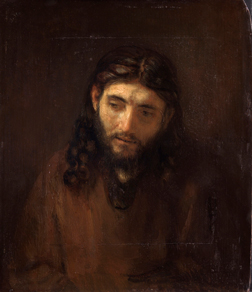by Lou Baldwin

PHILADELPHIA (CNS) – Matthew, Mark, Luke and John told us all about what Jesus said and did, but not one of them mentioned what he looked like.
The vaguely European-featured Jesus with a brown beard and hair was pretty much the standard for most of history, at least until Rembrandt van Rijn, the greatest painter, draftsman and printmaker of the Dutch Golden Age, came along. In the mid-17th century he and students at his Amsterdam studio painted a series of at least eight heads of Christ which set the liturgical art world on its ear.
Rembrandt’s studio was in a section of Amsterdam with a fairly large Jewish population, and it is believed the same young Jewish man was the model for all the portraits, which look remarkably like the olive-skinned and dark-haired men you would see strolling the Galilee shore today.
For the first time six of these paintings are brought together for an exhibit, “Rembrandt and the Face of Jesus,” which was first exhibited at the Louvre in Paris and now at the Philadelphia Museum of Art (Aug. 3-Oct. 30) after which it will travel to the Detroit Institute of Art (Nov. 20-Feb. 12).
“‘Rembrandt and the Face of Jesus’ marks the first time that an exhibition including a substantial group of paintings by Rembrandt will be seen in Philadelphia,” said Timothy Rub, director and chief executive officer of the Philadelphia Museum of Art.
In his day Rembrandt was ridiculed for his innovative portrayal of the Savior. By long-standing tradition, the head of Jesus was taken from three sources – Veronica’s veil, which according to tradition was imprinted with the image of Jesus after a woman wiped his face on the road to Golgotha; the Mandylion of Edessa, a similar icon venerated in the East; and the Lentulus letter, a written description of Christ purportedly written by the governor of Judea who preceded Pontius Pilate.

However, the Lentulus letter is generally dismissed as a 15th-century forgery, and neither Veronica’s veil nor the Mandylion can be definitively traced to the first century.
In addition to the six heads of Jesus, the Philadelphia museum exhibit contains other Rembrandt works drawn from the great museums of America and Europe showing the artist’s transition from the traditional to the innovative. Especially noteworthy are “Supper at Emmaus” and “Christ Preaching” (The Hundred Guilder Print), both from the Louvre.
Although a number of the paintings and prints in the exhibit are from the Philadelphia Museum’s collection, it includes only one “Head of Jesus.” It is part of the vast John G. Johnson collection and was until recently in storage, because it was thought to be a more recent copy of Rembrandt’s work. Typical of Rembrandt’s period, it is painted on oak, and by close examination it was originally a smaller portrait pieced into a larger panel, with a background almost seamlessly painted to form a single panel.
When Lloyd DeWitt arrived at the museum a decade ago as associate curator of the Johnson collection, he was “extremely puzzled why someone would take such time on a copy and piece it together,” said Jennifer Thompson, associate curator of European paintings and sculpture before 1900.
DeWitt consulted with Peter Kline, a wood biologist who has an international reputation for dating the panels works are painted upon. Through examination of the pattern of tree rings on the two panels, he was able to determine the main panel was from a tree harvested during Rembrandt’s Amsterdam years, and the surrounding panel was even earlier, about 1610, which made it almost a certainty the picture was from Rembrandt’s studio, not a later copy.
With the “Head of Jesus” authenticated, DeWitt conceived the notion of the exhibit with the Philadelphia museum’s work as a starting point.
Although DeWitt himself recently moved on to the Art Gallery of Toronto in his native Canada, “he was the first to think about bringing all of the heads together for an exhibit,” Thompson said.
